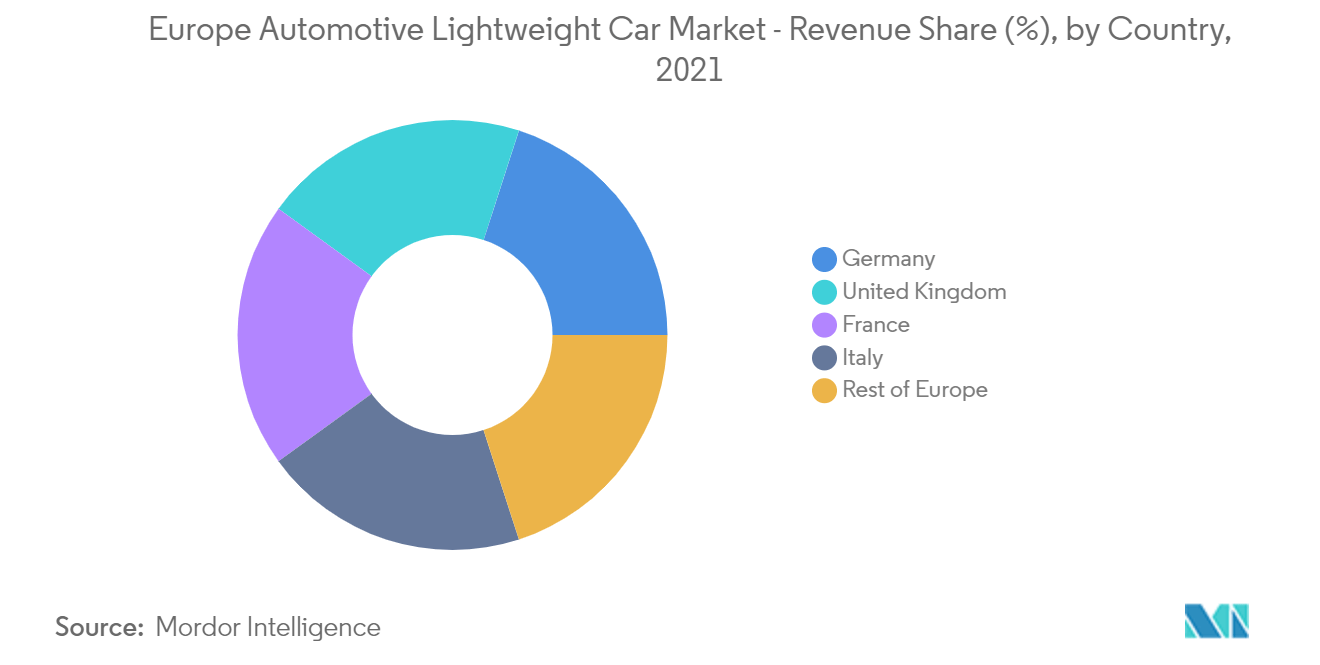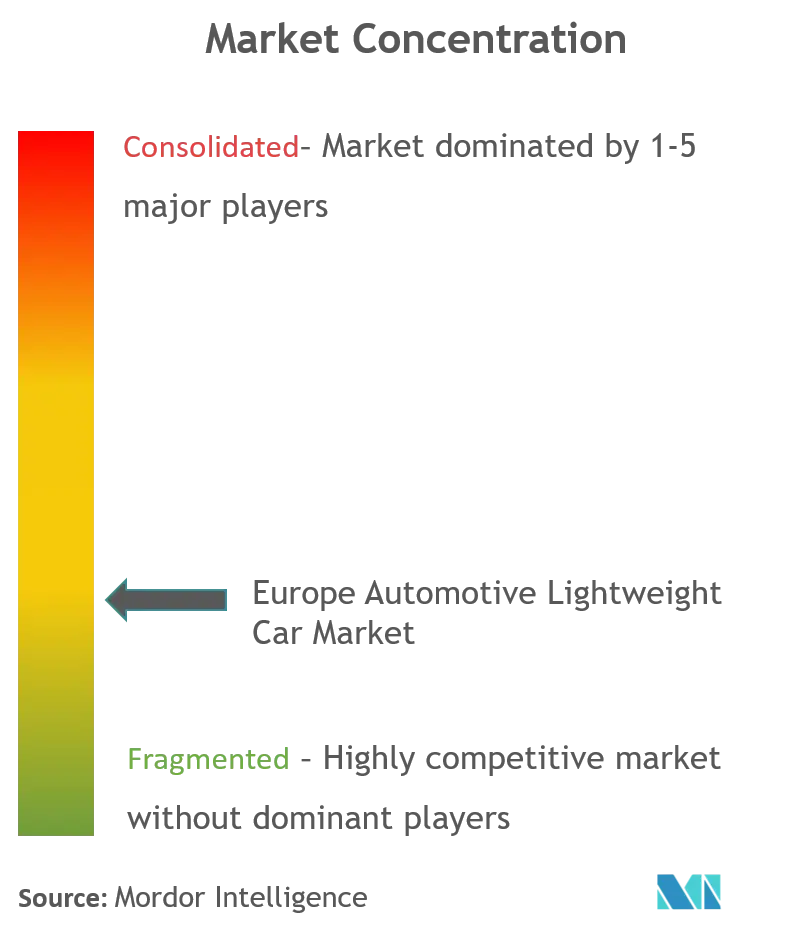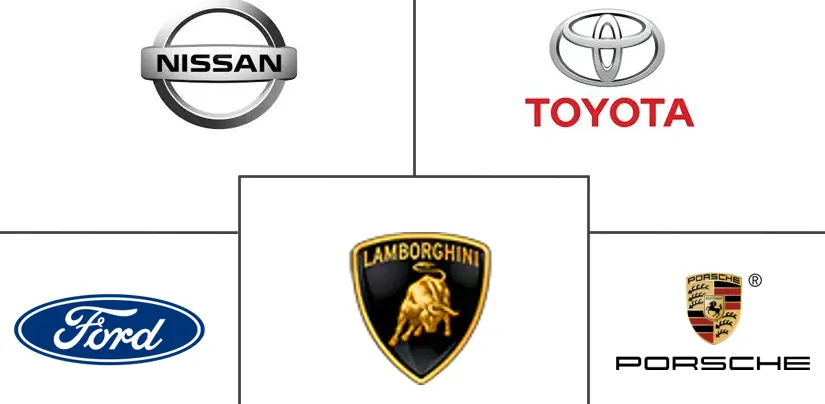Europe Automotive Lightweight Car Market Size and Share

Europe Automotive Lightweight Car Market Analysis by Mordor Intelligence
The Europe Automotive Lightweight Car Market is expected to register a CAGR of greater than 9% during the forecast period.
The COVID-19 pandemic hindered the growth of the market as lockdowns and shutdowns of manufacturing facilities across Europe during 2020 resulted in delays in the delivery of key models and a decline in the production of the vehicles.
However, restrictions eased across major countries in Europe by the first half of 2021, and demand started slowly picking up pace however the market is still impacted by supply chain disruptions caused by the ongoing Russia-Ukraine war. Despite such challenges during the forecast period owing to the presence of key sports car manufacturers across countries like Germany, United Kingdom, etc. the market is anticipated to see positive trends in the market during the forecast period.
Over the medium term, increasing regulations to reduce emissions along with increasing demand for fuel economy are expected to grab the attention of OEM manufacturers to decrease the overall automobile weight. In addition, an increase in automotive production, and growing consumer interest to adopt safe and comfort features are anticipated to further boost demand in the market.
However, the high price of lightweight materials, such as carbon fibers as well as few composite materials compared to generic materials increases the overall cost of the vehicle and this is expected to restrict the market growth. Besides this, various research activities to reduce the cost of materials are expected to abate the effect of this restraint in the coming years.
The surge in the production of electric vehicles is expected to propel the growth of the lightweight car market over the coming years across the region. Lightweight materials such as carbon-fiber-reinforced plastic are used in modern electric vehicles, allowing them to run purely on electricity and avoid being classified as hybrids. Besides these, New product developments and compositions are gaining significant popularity in the market as the adoption of the latest technologies offers new opportunities for players in the market.
Germany, United Kingdom, France, and Italy are expected to play a dominant role in the growth of the market during the forecast period. These countries have stringent emission norms for automobiles because of increasing carbon percent in the environment at an alarming rate creating a positive outlook for the market. Further, the presence of key sports car manufacturers like Porsche, Lamborghini, and others is likely to augment the demand in the market during the forecast period.
Europe Automotive Lightweight Car Market Trends and Insights
Continuous Evolution in Automotive AHSS Technology to Enhance Market Growth
There is a demand for reducing weight to enhance vehicle performance and safety. As a result, Advanced High Strength Steel (AHSS), an essential material for mass vehicle reduction, has become one of the fastest-growing materials in today's automotive industry. Steel makes up around 70 % of an average automobile's weight. Compared to standard steel, AHSS enables to reduce vehicle weight by 23-35% which is around 165 to 250 kg, for a regular passenger car, saving 3 - 4.5 tons of greenhouse gases over the vehicle's total life cycle. This saving in emissions is much more substantial than the CO2 emitted during the complete production of steel needed in a car.
The steel composition involves 34% of the body structure, panels, doors, and trunk closures, giving it energy absorption and high strength in case of a crash. 23% is the engine and machinable carbon steel for the wear-resistant gears. 12% is used in the suspension, using rolled high-strength steel, and the remainder in the wheels, tires, fuel tank, steering, and braking systems. In wake of such developments, some key companies operating are taking necessary initiatives in this regard to improve their presence in the market. For instance,
- In February 2022, Thyssenkrupp completed the sale of Acciai Speciali Terni (AST) including the associated sales organization in Germany, Italy, and Turkey to the Italian company Arvedi. The sale was contractually agreed in September 2021. Both parties have agreed not to disclose the financial details of the transaction. It has been agreed with the acquirer Arvedi that thyssenkrupp will retain shares in the amount of 15% in AST to strengthen the already existing operating cooperation with Arvedi through such a minority shareholding.
To produce higher strength for reduced steel section size and weight, automakers use less material, significantly reducing a vehicle's weight. The steel industry is focusing on developing different alloys for processing combinations, steel with high tensile strength and ductility, along with optimized chemical compositions to achieve multiphase microstructures of AHSS. Market players are developing new products to widen their consumer base. This is likely to intensify the competition in the global automotive lightweight materials market in the next few years.
Other advancements include the expanded capabilities of automotive steels that have high strength, which enable the design of thinner parts optimizing stiffness but maintaining geometries. AHSS such as Nano Steel helps deliver thinner gauges of steel and components to manufacture at room temperature. The aforementioned trends in the European market are anticipated to offer lucrative opportunities for players operating in the market during the forecast period.

Germany Expected to Lead the European lightweight Car Industry During the Forecast Period
The German segment of the market is expected to hold a significant share of the market during the forecast period. Germany is home to 41 automobile assembly and engine production plants with a capacity of more than one-third of European automobile production. Many German companies are experimenting with new composites that can reduce the vehicle's total weight to a great extent. The application of carbon-fiber-reinforced plastic (CFRP) has been widely adopted to produce automotive bodies, particularly in German-manufactured cars, such as BMW, Porsche, and Audi. For instance,
- In August 2022, Porsche revealed the new Porsche 911 GT3 RS with a 4.0-liter high-revving naturally aspirated engine with racing DNA and intelligent lightweight construction paired with a seven-speed Porsche Doppelkupplung (PDK) transmission. The 911 GT3 RS accelerates from zero to 100 km/h in 3.2 seconds and reaches a top speed of 296 km/h in the seventh gear.
According to several research reports, vehicle manufacturers are likely to increase lightweight component levels from 30 percent to 70 percent by 2030 to compensate for electric drive weight increases and more efficient engine technology in the coming years. With the market for lightweight vehicles in development, various initiatives within Germany are driving technological advancements. As per, the regulatory framework (Euro 6 norms), there is a growing motivation for a low-carbon economy by 2050.
- Research organizations such as the Affordable Lightweight Automobiles Alliance(AFLA) are specialized to deal with automotive light-weighting, which is co-funded by the European Commission's Horizon 2020 and EUCAR, the European Council for Automotive R&D.
Besides these, European carmakers such as Daimler, Volkswagen, Fiat-Chrysler Research Centre, Volvo, Opel, and Toyota are also working together to produce more efficient vehicles. Their goal is to reduce energy consumption by 10% and global warming potential (GWP) by 6% by reducing the vehicle's weight by 31 to 33% while maintaining the cost. Such trends in the Market are expected to enhance the overall growth of the Germany segment of the market during the forecast period.

Competitive Landscape
The Europe lightweight car market is moderately consolidated with existing players such as Volkswagen, Nissan Corporation, Toyota, Hyundai, and other key OEMs operating in the European market. As the demand for lightweight cars is growing in the region, while some key automotive manufacturers are trying to edge over their competitors by making joint ventures, partnerships, and launching new products with advanced technology, other raw material, and component suppliers are focusing on improving their product offerings. For instance,
- In July 2022, Gestamp announced that Arcelor Mittal and Gestamp have successfully trialed the use of low-carbon emissions steel for car parts that will ultimately be used in the production of vehicles in Europe. They have signed an agreement to cooperate on sustainability, specifically in the production of low-carbon emissions steel parts, and are working closely to ensure that ArcelorMittal's steel meets all Gestamp's technical requirements.
- In May 2021, The all-new Qashqai Nissan's first model built in Europe using a significant number of lightweight aluminum panels has been launched into the market. The hood, doors and front fenders are stamped from aluminum alloy, which makes the body of the all-new Qashqai 60 kg lighter. This improves efficiency and thereby contributes to reduced emissions. In addition, it helps accommodate more technology, including the all-new vehicle's electrified powertrain.
- In June 2021, Porsche announced that a new generation of the 911 GTS model is being launched into the market. The driving dynamics of the model are further improved with the Lightweight Design package, which will be available for the first time for the GTS from November 2021. Up to 25 kg will be saved by the lighter carbon fiber reinforced plastic (CFRP) full bucket seats, lightweight glass for the side and rear windows, and lightweight battery.
- In May 2021, Toray Industries, Inc. announced that it has developed a high thermal conductivity technology for carbon fiber-reinforced plastic (CFRP). A thermally conductive layer composed of a porous CFRP support and graphite sheets is stacked on CFRP to achieve both lightweight and high thermal conductivity. Toray intends to promote the new technology for applications including battery parts of electric vehicles (EV), advanced mobility, and electronic devices.
Europe Automotive Lightweight Car Industry Leaders
-
Nissan Motor Corporation
-
Toyota Motor Corporation
-
Ford Motor Company Ltd.
-
Porsche AG.
-
Automobili Lamborghini S.p.A.
- *Disclaimer: Major Players sorted in no particular order

Recent Industry Developments
- In August 2022, Automobili Lamborghini announced the Urus Performante. It has a V8 twin-turbo powerplant and a lightweight sports exhaust. The Performante's power is increased by 16 CV to 666 CV, and its weight is reduced by 47 kg, giving it a best-in-class weight-to-power ratio of 3,2.
- In March 2022, Renault Europe launched Megane E-TECH Electric, the first model of its '2.0 generation' of electric vehicles to benefit from the advantages of the Alliance's CMF-EV platform. Megane E-TECH Electric symbolizes the beginning of the announced reconquest of the compact vehicle segment.
- In March 2022, Lotus unveiled an all-electric crossover SUV called Eletre, with super-fast performance, futuristic hardware, and an aggressive design. The announcement comes days after fellow European automaker Maserati unveiled the Grecale, its first all-electric SUV. They will both join the list of current and upcoming SUVs from other premium automakers, including the Audi e-Tron, Jaguar i-Pace, Mercedes-Benz EQC, BMW iX, and more.
- In May 2021, Nissan launched an all-new Qashqai that will be built in Europe using a significant number of lightweight aluminum panels. The hood, doors, and front fenders are stamped from aluminum alloy, which makes the body of the all-new Qashqai 60 kg lighter. This improves efficiency and thereby contributes to reduced emissions. In addition, it helps accommodate more technology, including the all-new vehicle's electrified powertrain.
Europe Automotive Lightweight Car Market Report Scope
Light weighting is a concept in the auto industry about building cars that are less heavy to achieve better fuel efficiency and handling. Carmakers make parts from carbon fiber, windshields from plastic, and bumpers out of aluminum foam, as ways to lessen vehicle load.
The Europe lightweight cars market report covers the current and upcoming trends with recent technological developments in various market areas by materials, manufacturing process, and application type. The scope of the report covers segmentation based on Material Type, Manufacturing Process, Application type, and Country.
By Material type, the market is segmented into Metals, Composites, and Plastics. By Manufacturing Process, the market is segmented into Extrusion, Stamping, Forging, Casting, and Others (Molding and Forming).
By Application, the market is segmented into Structural, Powertrain, Interior, and Exterior. By Country, the market is segmented into Germany, United Kingdom, France, Italy, Rest of Europe. For each segment, market size and forecast have been done on basis of value (USD billion).
| Metals |
| Composites |
| Plastics |
| Extrusion |
| Stamping |
| Forging |
| Casting |
| Others |
| Structural |
| Powertrain |
| Interior |
| Exterior |
| Material Types | Metals |
| Composites | |
| Plastics | |
| Manufacturing Process | Extrusion |
| Stamping | |
| Forging | |
| Casting | |
| Others | |
| Application | Structural |
| Powertrain | |
| Interior | |
| Exterior |
Key Questions Answered in the Report
What is the current Europe Automotive Lightweight Car Market size?
The Europe Automotive Lightweight Car Market is projected to register a CAGR of greater than 9% during the forecast period (2025-2030)
Who are the key players in Europe Automotive Lightweight Car Market?
Nissan Motor Corporation, Toyota Motor Corporation, Ford Motor Company Ltd., Porsche AG. and Automobili Lamborghini S.p.A. are the major companies operating in the Europe Automotive Lightweight Car Market.
What years does this Europe Automotive Lightweight Car Market cover?
The report covers the Europe Automotive Lightweight Car Market historical market size for years: 2019, 2020, 2021, 2022, 2023 and 2024. The report also forecasts the Europe Automotive Lightweight Car Market size for years: 2025, 2026, 2027, 2028, 2029 and 2030.
Page last updated on:
Europe Automotive Lightweight Car Market Report
Statistics for the 2025 Europe Automotive Lightweight Car market share, size and revenue growth rate, created by Mordor Intelligence™ Industry Reports. Europe Automotive Lightweight Car analysis includes a market forecast outlook for 2025 to 2030 and historical overview. Get a sample of this industry analysis as a free report PDF download.



